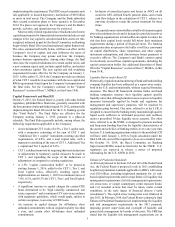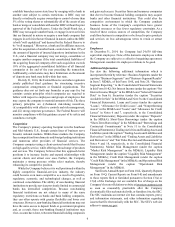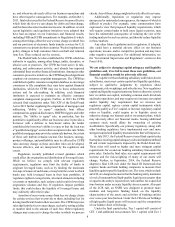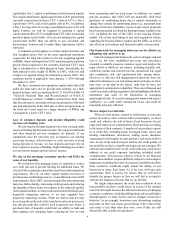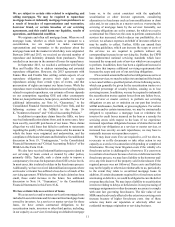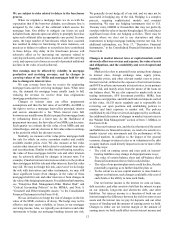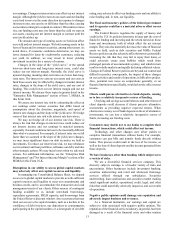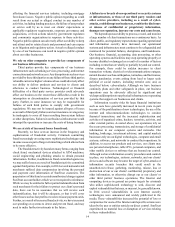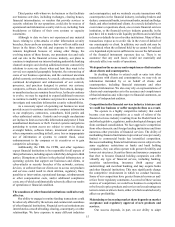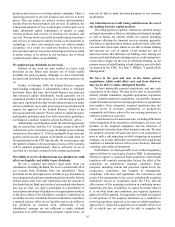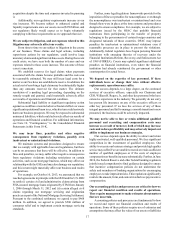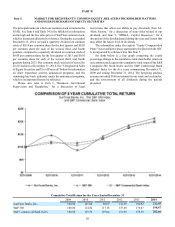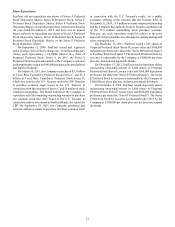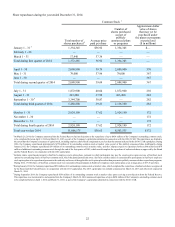SunTrust 2014 Annual Report Download - page 35
Download and view the complete annual report
Please find page 35 of the 2014 SunTrust annual report below. You can navigate through the pages in the report by either clicking on the pages listed below, or by using the keyword search tool below to find specific information within the annual report.12
We are subject to risks related to delays in the foreclosure
process.
When we originate a mortgage loan, we do so with the
expectation that if the borrower defaults, our ultimate loss is
mitigated by the value of the collateral which secures the
mortgage loan. Our ability to mitigate our losses on such
defaulted loans depends upon our ability to promptly foreclose
upon such collateral after an appropriate cure period. In some
states, the large number of foreclosures which have occurred
has resulted in delays in foreclosing. In some instances, our
practices or failures to adhere to our policies have contributed
to these delays. Any delay in the foreclosure process will
adversely affect us by increasing our expenses related to
carrying such assets, such as taxes, insurance, and other carrying
costs, and exposes us to losses as a result of potential additional
declines in the value of such collateral.
Our earnings may be affected by volatility in mortgage
production and servicing revenues, and by changes in
carrying values of our MSRs and mortgages held for sale
due to changes in interest rates.
We earn revenue from fees we receive for originating
mortgage loans and for servicing mortgage loans. When rates
rise, the demand for mortgage loans usually tends to fall,
reducing the revenue we receive from loan originations
(mortgage production revenue).
Changes in interest rates can affect prepayment
assumptions and thus the fair value of our MSRs. An MSR is
the right to service a mortgage loan-collect principal, interest
and escrow amounts-for a fee. When interest rates fall,
borrowers are usually more likely to prepay their mortgage loans
by refinancing them at a lower rate. As the likelihood of
prepayment increases, the fair value of our MSRs can decrease.
Each quarter we evaluate the fair value of our MSRs and any
related hedges, and any decrease in fair value reduces earnings
in the period in which the decrease occurs.
Similarly, we measure at fair value prime mortgages held
for sale for which an active secondary market and readily
available market prices exist. We also measure at fair value
certain other interests we hold related to residential loan sales
and securitizations. Similar to other interest-bearing securities,
the value of these mortgages held for sale and other interests
may be adversely affected by changes in interest rates. For
example, if market interest rates increase relative to the yield on
these mortgages held for sale and other interests, their fair value
may fall. We may not hedge this risk, and even if we do hedge
the risk with derivatives and other instruments, we may still
incur significant losses from changes in the value of these
mortgages held for sale and other interests or from changes in
the value of the hedging instruments. For additional information,
see “Enterprise Risk Management-Other Market Risk” and
“Critical Accounting Policies” in the MD&A, and Note 9,
“Goodwill and Other Intangible Assets,” to the Consolidated
Financial Statements in this Form 10-K.
We use derivatives to hedge the risk of changes in the fair
value of the MSR, exclusive of decay. The hedge may not be
effective and may cause volatility, or losses, in our mortgage
servicing income. Also, we typically use derivatives and other
instruments to hedge our mortgage banking interest rate risk.
We generally do not hedge all of our risk, and we may not be
successful in hedging any of the risk. Hedging is a complex
process, requiring sophisticated models and constant
monitoring. We may use hedging instruments tied to U.S.
Treasury rates, LIBOR or Eurodollars that may not perfectly
correlate with the value or income being hedged. We could incur
significant losses from our hedging activities. There may be
periods where we elect not to use derivatives and other
instruments to hedge mortgage banking interest rate risk. For
additional information, see Note 17, “Derivative Financial
Instruments,” to the Consolidated Financial Statements in this
Form 10-K.
Changes in market interest rates or capital markets could
adversely affect our revenue and expense, the value of assets
and obligations, and the availability and cost of capital and
liquidity.
Market risk refers to potential losses arising from changes
in interest rates, foreign exchange rates, equity prices,
commodity prices, and other relevant market rates or prices.
Interest rate risk, defined as the exposure of net interest income
and MVE to adverse movements in interest rates, is our primary
market risk, and mainly arises from the nature of the loans on
our balance sheet. We are also exposed to market risk in our
trading instruments, AFS investment portfolio, MSRs, loan
warehouse and pipeline, and debt and brokered deposits carried
at fair value. ALCO meets regularly and is responsible for
reviewing our open positions and establishing policies to
monitor and limit exposure to market risk. The policies
established by ALCO are reviewed and approved by our Board.
See additional discussion of changes in market interest rates in
the "Market Risk Management” section of Item 7, MD&A, in
this Form 10-K.
Given our business mix, and the fact that most of the assets
and liabilities are financial in nature, we tend to be sensitive to
market interest rate movements and the performance of the
financial markets. In addition to the impact of the general
economy, changes in interest rates or in valuations in the debt
or equity markets could directly impact us in one or more of the
following ways:
• The yield on earning assets and rates paid on interest-
bearing liabilities may change in disproportionate ways;
• The value of certain balance sheet and off-balance sheet
financial instruments that we hold could decline;
• The value of our pension plan assets could decline, thereby
potentially requiring us to further fund the plan; or
• To the extent we access capital markets to raise funds to
support our business, such changes could affect the cost of
such funds or the ability to raise such funds.
Our net interest income is the interest we earn on loans,
debt securities, and other assets we hold less the interest we pay
on our deposits, long-term and short-term debt, and other
liabilities. Net interest income is a function of both our net
interest margin-the difference between the yield we earn on our
assets and the interest rate we pay for deposits and our other
sources of funding-and the amount of earning assets we hold.
Changes in either our net interest margin or the amount of
earning assets we hold could affect our net interest income and



